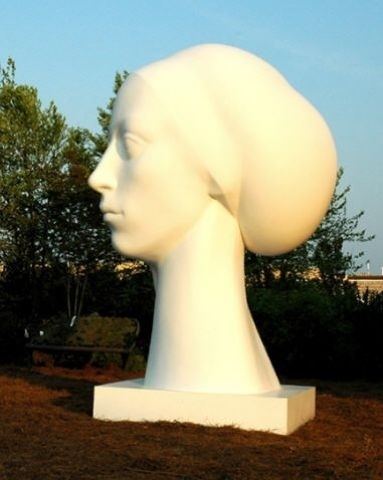Name Philip Grausman | ||
 | ||
Education Cranbrook Educational Community, Art Students League of New York | ||
Philip Grausman Top #19 Facts
Philip Grausman (born July 16, 1935) is an American sculptor who continues to push the limits of the time-honored portrait in art. His early work focused on natural forms representing buds and seeds, and this exploration led him to the underlying structure and form of the human head. His monumental heads of fiberglass display a subtle hand, and the lack of detail makes a stunning presentation. He also continues to create reductivist portraits at normal scale, experimenting with various metals with matte finishes to accomplish his vision.
Contents
- Philip Grausman Top 19 Facts
- Grausman Sculpture at McNay Museum of Art
- Education
- Solo exhibitions
- Awards
- United States
- Teaching
- References
Grausman has received numerous awards, including the Rome Prize in Sculpture, a Ford Foundation Purchase Award, and grants from the National Institute of Arts and Letters and The Louis Comfort Tiffany Foundation among others. His many solo and group exhibitions of sculpture and drawings have been displayed throughout the U.S.
In 1959, Grausman studied with Jose de Creeft at the Art Students League in New York City and earned a MFA from the Cranbrook Academy of Art in Michigan. His work is included in the collections of the Metropolitan Museum of Art, New York City; the Brooklyn Museum, Brooklyn, New York; and the Wadsworth Atheneum, Hartford, Connecticut. Grausman has participated in over eighty solo and group exhibitions at prestigious venues throughout the world, a selection of which includes the National Academy of Design, New York City; Whitney Museum of American Art, New York City; New Arts Gallery, Litchfield, Connecticut; Hollycroft Foundation, The Sculpture Mile, Madison, Connecticut; Pier Walk 2000, Navy Pier, Chicago; DeCordova Museum and Sculpture Park, Lincoln, Massachusetts; Wadsworth Atheneum, Hartford, Connecticut; and the American Academy in Rome, Italy. He has also contributed to the Art in Embassies Program through the U.S. State Department in Washington, D.C. His work is included in various private, museum, and university collections, such as the Baltimore Museum of Art, Maryland; Louis B. Mayer Foundation, Los Angeles; Columbus Museum of Art, Ohio; and the Museum of Contemporary Art, Udine, Italy. Grausman is also known for his studies of birds.
Mario Naves wrote in The New York Observer (August 26, 2008):
"I couldn’t help but wonder what Mr. Grausman’s portrait-heads would look like at, say, MoMA. Both measure roughly 10 feet high and require a significant amount of viewing distance—they could, I think, command MoMA’s enormous contemporary galleries without strain, and maybe with finesse. The proportions of each are as deliberate, if not as overweening, as the museum’s spaces. The coloration of Susanna and Eileen—an emphatic and velvety white—might transform MoMA’s refrigeratorlike ambience into something like the Parthenon.
That’s a stretch, but Mr. Grausman’s profound debt to the art of antiquity renders it not altogether inappropriate. Susanna and Eileen have been shaped with a silky emphasis on idealization—contours slope elegantly, symmetry quietly emphasized, with facial features stoic and streamlined. Though Mr. Grausman’s industrial material retains a certain artificial patina, it ultimately recalls the quarry rather than the factory. A tendency toward abstraction—universality, really—underlines the artist’s belief that art can traverse and find meaning within cultures the world over.
Grace Glueck wrote in The New York Times (June 19, 1998),
“Sculpture portraits stripped to essence are Mr. Grausman’s forte. Concentrating on volume and form, eliminating inconsequential details, he models faces of expressive vitality by emphasizing their structure and contours. His surfaces are integral to the work: metal, pewter, aluminum and stainless steel in gray tones that add to the distinction of these streamlined but powerful presences. Mr Grausman’s drawings of nudes, eloquent essays in pure line, are, like his sculptures, distinctive for what they leave out.”
Michael Brenson wrote in The New York Times (November 20, 1987),
"Mr. Grausman has described his heads as landscapes, and indeed his aluminum seems to sprout and swell like trees and fruit. In looking for a way of extending the tradition of sculpture from nature, he has found a surprising path."
Hilton Kramer wrote in The New York Times (October 5, 1979),
"The portrait sculpture of Philip Grausman is quite unlike anything else on the contemporary art scene today. For one thing, his portraits are real portraits. They address themselves to character and personality, and attempt an account of them. They are not simply a value accumulation of three-dimensional gestures in search of some associations with a recognizable subject. For another, they are real sculpture. Their form is compelling, their surfaces have an astonishing clarity and finish, and they have a haunting physical presence. In a period when portrait sculpture of significant quality is a rarity, Mr. Grausman works as if it were a flourishing genre – and in his portraits, it is. Mr. Grausman is a phenomenon."
